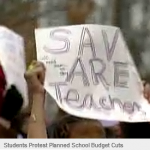The unshackling of the MSM — and, to a lesser extent, their erstwhile brethren in the Democratic Party — from the clutches of the nation’s teachers’ unions continues apace.
In defiance of what must have been intense pressure from organized labor and the Los Angeles education establishment, the Los Angeles Times just published an incredible series of stories on the effectiveness of the city’s 6,000 teachers.
The Times, which over the years hasn’t exactly been a great friend of conservatives, has shown tremendous bravery in going forward with this package, which juxtaposes students’ performances on standardized tests with the teachers in their classrooms. The paper calls it a “value-added analysis.”
Among other things, the study found that:
After a single year with teachers who ranked in the top 10% in effectiveness, students scored an average of 17 percentile points higher in English and 25 points higher in math than students whose teachers ranked in the bottom 10%. Students often backslid significantly in the classrooms of ineffective teachers, and thousands of students in the study had two or more ineffective teachers in a row.
Predictably, L.A teachers’ union boss A.J. Duffy has called for a “massive boycott” of the Times because the data and the stories might be “leading people in a dangerous direction.”
In other words, some of his chronically under-performing union buddies might lose their jobs. Don’t look for sympathy to the hundreds of thousands of L.A. kids and their parents who have been ill-served by a crime-ridden and dysfunctional school system.
Opposition by union bosses to the unflattering report rings hollow and hypocritical, for we all know that if the data had proved otherwise, Duffy and the American Federation of Teachers would be falling all over themselves to claim credit.
Interestingly, Obama Education Secretary Arne Duncan came out in favor of the series, asking the obvious question, “What’s there to hide?” California Secretary of Education Bonnie Reiss added her two cents: “Publishing this data is not about demonizing teachers,” Reiss said. “It’s going to create a more market-driven approach to results.”
I taught high school English for a dozen years. And it is certainly true that, just as we shouldn’t judge a student’s intellect on test performances alone, so, too, should we avoid evaluating a teacher’s competence based strictly on those same scores. But the notion that we should suppress the data because it might give the wrong impression to the public is ludicrous on its face.
The Times did a commendable job of providing context to the results. And notwithstanding Mr. Duffy’s sneering condescension, the public is smart enough to evaluate what the data mean — not only to the profession, but to their own children’s education.
It is difficult to overstate the courage the Times showed in publishing this series in the face of virulent opposition from national union boss Randi Weingarten, as well as the left-leaning politicians and sympathetic public-sector unions that dominate the state of California.
But I’ll bet that for every subscription cancelled, there is a southern California businessman who takes out an ad in the Times in the hope that this series just might help produce a more educated work force. On second thought, I can do better than bet. I’ll pray.


COMMENTS
Please let us know if you're having issues with commenting.